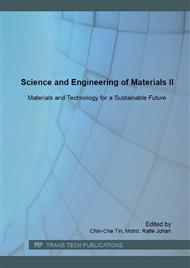[1]
K. Lee, S. Jeong, and J. Cho, Roles of surface chemistry on safety and electrochemistry in lithium ion batteries, Acc. Chem. Res., vol. 46, no. 5, p.1161–1170, (2013).
DOI: 10.1021/ar200224h
Google Scholar
[2]
D. Chen, L. He, and S. Shang, Study on aluminum phosphate binder and related Al2O3-SiC ceramic coating, Mater. Sci. Eng. A384, p.29–35, (2003).
DOI: 10.1016/s0921-5093(02)00643-3
Google Scholar
[3]
V. A. do R. Monteiro, E. F. ´. de Souza, M. M. M. de Azevedo, and F. Galembeck, Aluminum Polyphosphate Nanoparticles: Preparation, Particle Size Determination, and Microchemistry., J. Colloid Interface Sci., vol. 217, no. 2, p.237–248, (1999).
DOI: 10.1006/jcis.1999.6381
Google Scholar
[4]
N. Wang, Flame Retardancy of Polymer Nanocomposites based on Layered Aluminum Phosphate and Computational Study of Intercalation of Amines into α-Zirconium Phosphate and Adsorption of a Model Organic Pollutant, (2011).
Google Scholar
[5]
R. H. P. Devamani and A. M., Synthesis and Characterization of Aluminium Phosphate Nanoparticles, Int. J. Appl. Sci. Eng. Res., vol. 1, no. 6, p.769–775, Dec. (2012).
Google Scholar
[6]
E. Palacios, P. Leret, M. J. de la Mata, J. F. Fernández, A. H. De Aza, and M. a. Rodríguez, Influence of the pH and ageing time on the acid aluminum phosphate synthesized by precipitation, CrystEngComm, vol. 15, no. 17, p.3359, (2013).
DOI: 10.1039/c3ce00011g
Google Scholar
[7]
C. -S. Yang and K. -Y. Kau, Synthesis of Morphology Processable α-AlPO4 Nanoparticles , Nanowires and Multi-strand Nano-ropes, J. Chinese Chem. Soc., vol. 52, p.477–487, (2005).
DOI: 10.1002/jccs.200500069
Google Scholar
[8]
J. -G. Lee, B. Kim, J. Cho, Y. -W. Kim, and B. Park, Effect of AlPO4-Nanoparticle Coating Concentration on High-Cutoff-Voltage Electrochemical Performances in LiCoO2, J. Electrochem. Soc., vol. 151, no. 6, p. A801, (2004).
DOI: 10.1149/1.1723495
Google Scholar
[9]
F. Gutiérrez-Mora, K. C. Goretta, D. Singh, J. L. Routbort, S. Sambasivan, K. a. Steiner, J. Adabie, and K. K. Rangan, High-temperature deformation of amorphous AlPO4-based nano-composites, J. Eur. Ceram. Soc., vol. 26, no. 7, p.1179–1183, Jan. (2006).
DOI: 10.1016/j.jeurceramsoc.2004.12.036
Google Scholar
[10]
K. Kandori, N. Ikeguchi, A. Yasukawa, and T. Ishikawa, Synthesis of Mesoporous Spherical Aluminum Phosphate Particles Using Metal Ions, J. Colloid Interface Sci., vol. 202, no. 2, p.369–376, Jun. (1998).
DOI: 10.1006/jcis.1998.5414
Google Scholar
[11]
A. M. Saat, N. A. Latiff, S. Yaakup, and M. R. Johan, Synthesis and characterisation of composite partially phosphorylated polyvinyl alcohol – aluminium phosphate as protective coating, Mater. Res. Innov., vol. 18, no. 6, p.310–313, (2014).
DOI: 10.1179/1432891714z.000000000974
Google Scholar
[12]
B. Boonchom and S. Kongtaweelert, Study of kinetics and thermodynamics of the dehydration reaction of AlPO4 · H2O, J. Therm. Anal. Calorim., vol. 99, no. 2, p.531–538, Jun. (2010).
DOI: 10.1007/s10973-009-0113-5
Google Scholar
[13]
R. J. Kalbasi and E. Izadi, Hydrothermal synthesis of pure AlPO4-5 without fluoride medium: synthesis, characterization and application as a support, J. Porous Mater., vol. 20, p.547–556, Sep. (2013).
DOI: 10.1007/s10934-012-9627-5
Google Scholar
[14]
M. M. Beppu, Emilia Celma De Oliveira Lima, and Fernando Galembeck, Aluminum Phosphate Particles Containing Closed Pores : Preparation , Characterization , and Use as a White Pigment, J. Colloid Interface Sci., vol. 178, p.93–103, (1996).
DOI: 10.1006/jcis.1996.0097
Google Scholar


